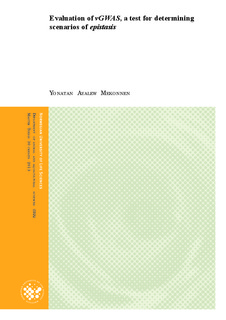| dc.contributor.author | Mekonnen, Yonatan Ayalew | |
| dc.date.accessioned | 2013-07-09T10:58:04Z | |
| dc.date.available | 2013-07-09T10:58:04Z | |
| dc.date.copyright | 2012 | |
| dc.date.issued | 2013-07-09 | |
| dc.identifier.uri | http://hdl.handle.net/11250/186175 | |
| dc.description.abstract | A number of software packages have been developed for the detection of epistatic QTL.
Nevertheless, none of these approaches could assure the optimal detection of epistasis. There are
a number of limitations in these studies including high computational demands due to increased
combinations of interactions for large datasets. Therefore, it has been a challenge to identify
genes which are responsible for complex genetic traits caused by epistasis as well as gene by
environment (G×E) interactions. Although genetic association studies have recently gained
popularity, most of these studies have been carried out on the effect of the markers’ mean trait
value without considering the differences in the variances of the traits. These differences could
be associated with detecting variance controlling loci and missing heritability. In this paper, we
address the novelty of variance genome wide association study (vGWAS) and evaluate its power
for the detection of epistasis. Data were generated using simulation program for two
chromosomes, both containing 209 markers. vGWAS – an R statistical package was used with
two and three loci epistasis model to analyze the simulated data. The Brown-Forsythe (Levene's)
test was used to assess the equality of group variance for variance controlling loci. For both two
and three loci epistasis models, correct QTL are detected. Both heritability and power are
calculated using three genotype-phenotype maps. Using vGWAS is therefore one way to find
some of the variation currently unexplained. Interaction variances ( ), which are included in
vGWAS analysis, is a novelty compared to other software in terms of detecting variance
controlling loci (vQTL) and finding the missing heritability due to interacting loci. In our
analysis, we have shown that at low or moderate noise level, both power and heritability
estimates were approximately 1. The result reflects that vGWAS is a powerful and efficient tool
for detecting candidate epistatic genes (i.e., detecting vQTL are often associated with interacting
genes). Therefore, it could be appropriate to be used as a procedure for real data dealing with
complex disease or obscured genetic interactions in addition to standard linear regression
models. | no_NO |
| dc.description.sponsorship | Erasmus mundus scholarship | no_NO |
| dc.language.iso | eng | no_NO |
| dc.publisher | Norwegian University of Life Sciences, Ås | |
| dc.subject | Epistasis | no_NO |
| dc.subject | heritability | no_NO |
| dc.subject | interaction variances | no_NO |
| dc.subject | power | no_NO |
| dc.subject | QTL | no_NO |
| dc.subject | vGWAS | no_NO |
| dc.subject | vQTL | no_NO |
| dc.title | Evaluation of vGWAS, a test for determining scenarios of epistasis | no_NO |
| dc.type | Master thesis | no_NO |
| dc.subject.nsi | VDP::Agriculture and fishery disciplines: 900::Agriculture disciplines: 910::Livestock breeding, rearing, reproduction: 912 | no_NO |
| dc.subject.nsi | VDP::Mathematics and natural science: 400::Basic biosciences: 470::Genetics and genomics: 474 | no_NO |
| dc.source.pagenumber | 78 | no_NO |
